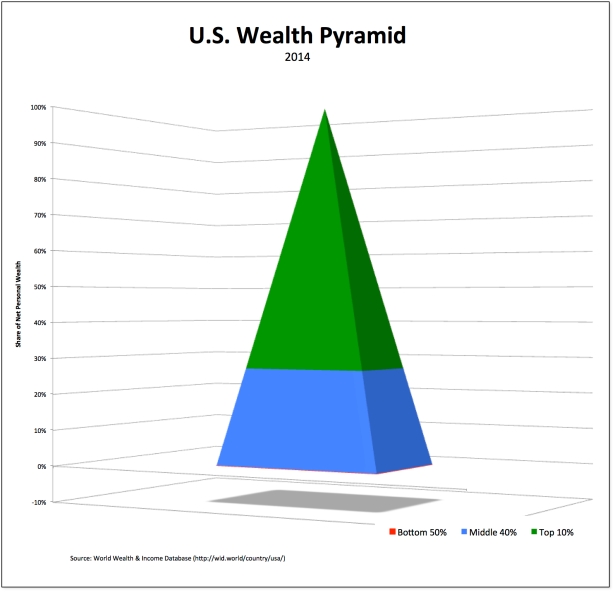On Wednesday, I referred to the wealth pyramid in the United States. But I didn’t really represent that pyramid in the chart I provided.
Here it is, above, with the wealth share of the bottom 50 percent (in red), the middle 40 percent (in blue), and the top 10 percent (in green)—a wealth pyramid for each year, from 1962 to 2014.
Or, here’s another, if you prefer a three-dimensional version of the latest year for which data are available. In 2014, the wealth share of the top 10 percent was 73 percent, while the middle 40 percent had 27 percent of net personal wealth. And the bottom 50 percent? It was exactly zero.
Now that is a real wealth pyramid!


Good job. As Always. Thank you. VIVA LA REVOLUCION
[…] Chart of the day […]
[…] United States, as I have shown over the past week (e.g., here, here, and here), has an obscenely unequal distribution of […]
[…] I have been arguing, since 2016 (e.g., here, here, and here), that one of the likely outcomes of the kind of corporate tax cuts Donald Trump and his fellow Republicans have supported—and, as we saw, eventually rammed through—would be an increase in inequality. That’s because corporations would likely use a portion of their higher profits to engage in stock buybacks, leading to an increase in stock prices. And stock ownership in the United States is already grotesquely unequal. Therefore, the rise in equity prices would disproportionately benefit the small group at the top of the wealth pyramid. […]
[…] I have been arguing, since 2016 (e.g., here, here, and here), that one of the likely outcomes of the kind of corporate tax cuts Donald Trump and his fellow Republicans have supported—and, as we saw, eventually rammed through—would be an increase in inequality. That’s because corporations would likely use a portion of their higher profits to engage in stock buybacks, leading to an increase in stock prices. And stock ownership in the United States is already grotesquely unequal. Therefore, the rise in equity prices would disproportionately benefit the small group at the top of the wealth pyramid. […]
[…] the rise in equity prices would disproportionately benefit the small group at the top of the wealth pyramid. And that’s exactly what is […]
[…] the rise in equity prices would disproportionately benefit the small group at the top of the wealth pyramid. And that’s exactly what is […]